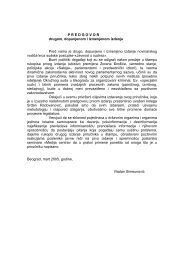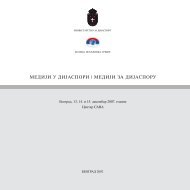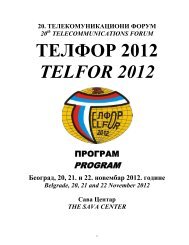Media Study - Medija centar Beograd
Media Study - Medija centar Beograd
Media Study - Medija centar Beograd
Create successful ePaper yourself
Turn your PDF publications into a flip-book with our unique Google optimized e-Paper software.
5.18 ANNEX – BROADCASTING LAW<br />
BROADCASTING LAW<br />
The Broadcasting Law was published in the Official Gazette of the RS No. 42/02 dated 19 July 2002. The<br />
amendments to this law were published in the Official Gazette of the RS Nos. 97/04, 76/05, 62/06 and<br />
85/06. The provision of Article 110 line 2 of the Advertising Law (Official Gazette of the RS No. 79/05)<br />
stipulates that the provisions of Articles 104-105, Articles 107-112 and Article 113 para. 1 items 16)-18)<br />
and items 20)-26) of the Broadcasting Law shall cease to apply as of the effective day of that law.<br />
- CONSOLIDATED TEXT - ©©<br />
I BASIC PROVISIONS<br />
Subject of the Law<br />
Article 1<br />
This Law stipulates the conditions for and manner of conducting broadcasting activities<br />
in keeping with international conventions and standards; establishes the Republican<br />
Broadcasting Agency, as well as public broadcasting service institutions; determines<br />
terms and procedures for the issuance of licences to broadcast radio and TV programmes;<br />
regulates other issues of relevance to the broadcasting sector.<br />
Article 2<br />
The provisions of this Law shall not pertain to the conditions and procedure for issuing<br />
radio station licences, or to the terms and procedure under which broadcasters gain the<br />
right to set up, use and maintain fixed and mobile broadcasting equipment.<br />
Principles Regulating Relations in the Broadcasting Sector<br />
Article 3<br />
The regulation of relations in the broadcasting sector shall be based on the following<br />
principles:<br />
1) Freedom, professionalism, and independence of public media outlets, as a guarantee<br />
of the overall development of democracy and social harmony;<br />
2) Rational and efficient use of the radio frequency spectrum as a limited natural<br />
resource;<br />
3) Prohibition of any censorship of and/or influence on the work of public media outlets,<br />
whereby their independence, the independence of their newsrooms and journalists is<br />
guaranteed;<br />
4) Full affirmation of civil rights and freedoms and especially the freedom of expression<br />
and plurality of opinion;<br />
©© The consolidated text of the Broadcasting Law has been prepared by the Technical Service of the<br />
Republican Broadcasting Agency. The Republican Broadcasting Agency has decided to do so considering<br />
that, by the latest amendments, the Legislative Committee of the National Assembly of the Republic of<br />
Serbia, as the only authorised body, is not authorised to determine the consolidated text of the Broadcasting<br />
Law. The Republican Broadcasting Agency has prepared the internal version of the consolidated text of the<br />
Broadcasting Law for its own needs and the needs of the radio and television stations (broadcasters) it<br />
supervises in the Republic of Serbia. The purpose of preparing this text is an easier application of the<br />
Broadcasting Law, considering the numerous amendments to the basic (original) text of this law.<br />
5) Application of internationally recognised norms and principles with respect to the<br />
broadcasting sector, especially the respect of human rights in this sector;<br />
6) Impartiality, prohibition of discrimination, and transparency of the procedure for<br />
issuing broadcasting licences.<br />
7) Encouraging the development of broadcasting and creativity in the field of radio and<br />
television in the Republic of Serbia.<br />
Definitions<br />
Article 4<br />
Unless otherwise specified, the terms used in this Law shall have the following meanings:<br />
1) Broadcasting: general term for radio and television as electronic mass media,<br />
achieved by the analogue or digital transmission of text, speech, sound, still and moving<br />
images in the form of programme contents via radio waves or cable distribution systems<br />
to adequate reception devices and intended for the general public.<br />
2) Radio frequency: main physical parameter of electromagnetic or radio waves freely<br />
moving through space, whose conventional values fall within the 3 KHz – 3000 GHz<br />
band;<br />
3) Coverage area: area in the vicinity of a transmitter providing the required field<br />
strength of the electromagnetic signal for a satisfactory service taking into account cochannel<br />
interference;<br />
166









